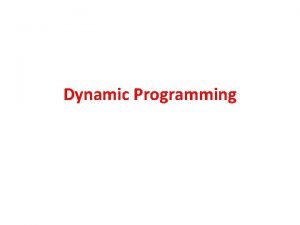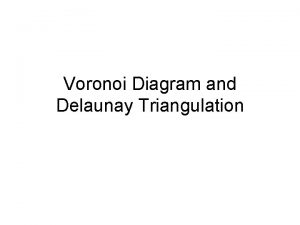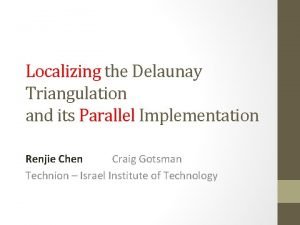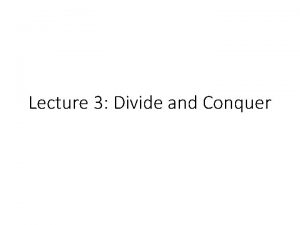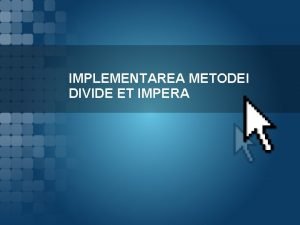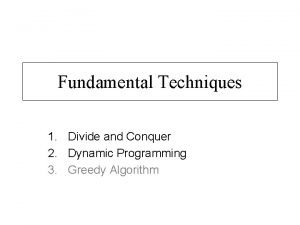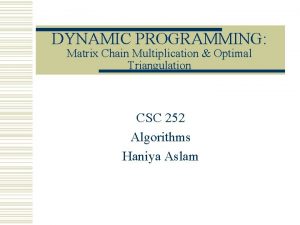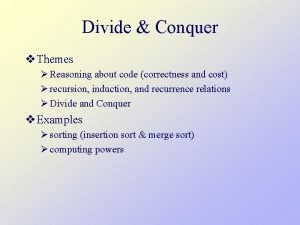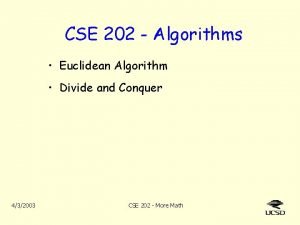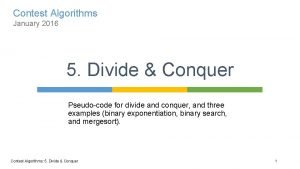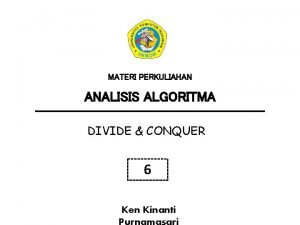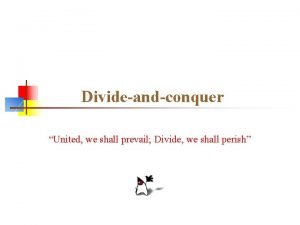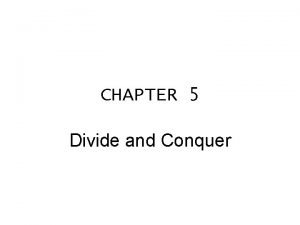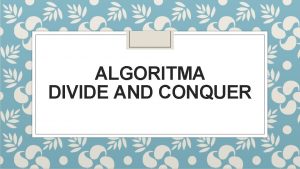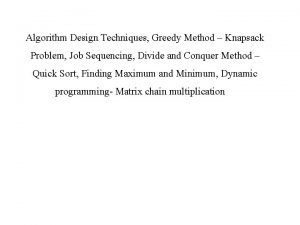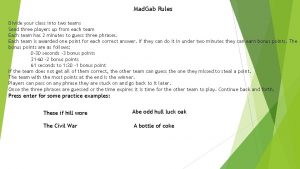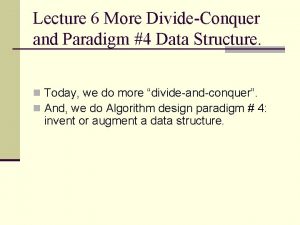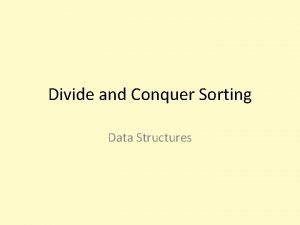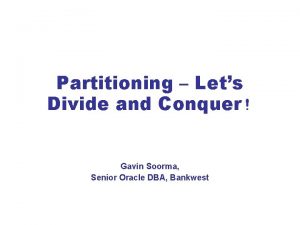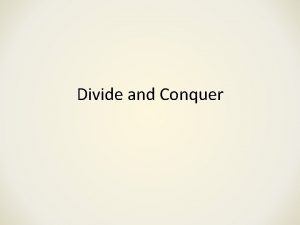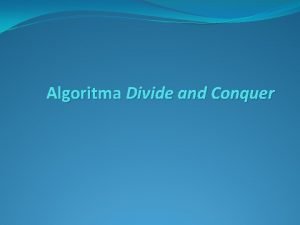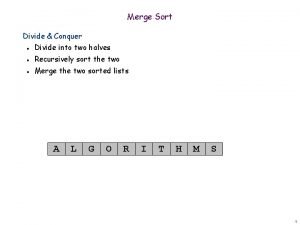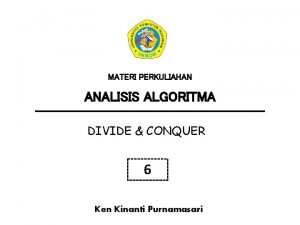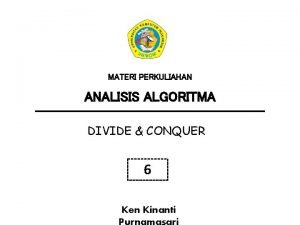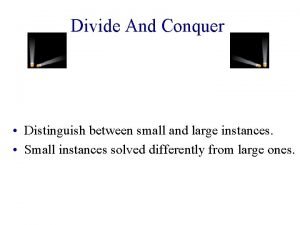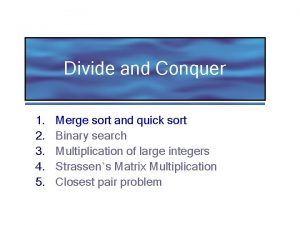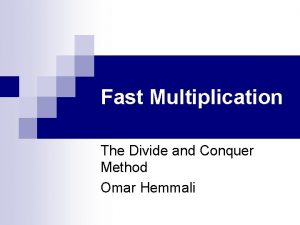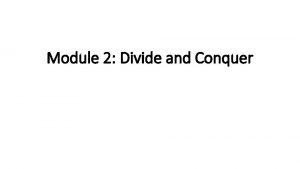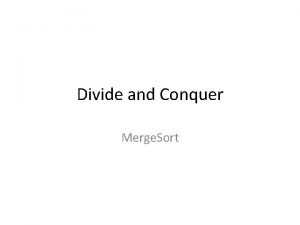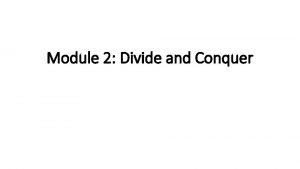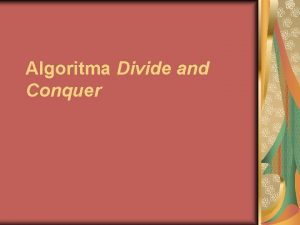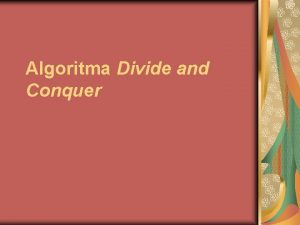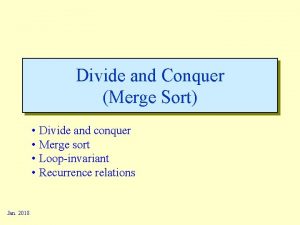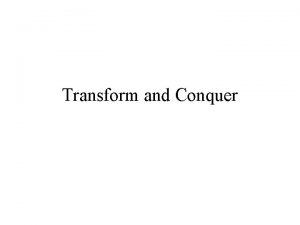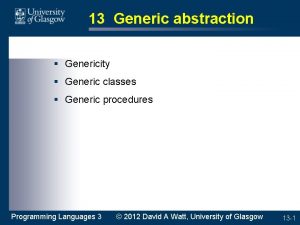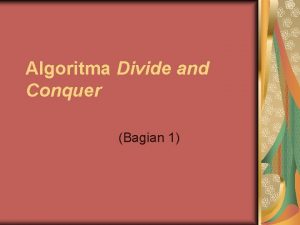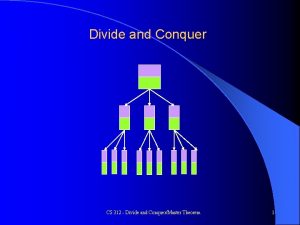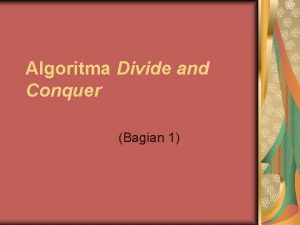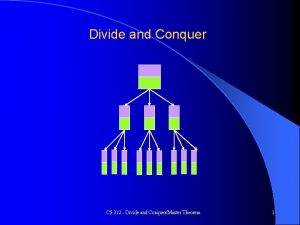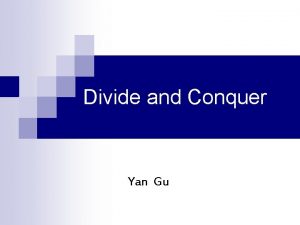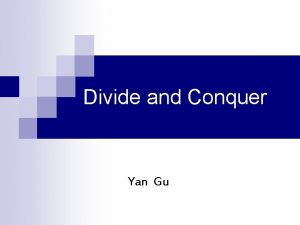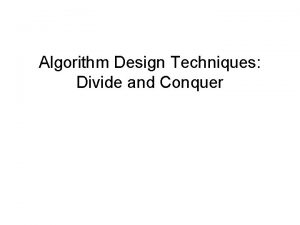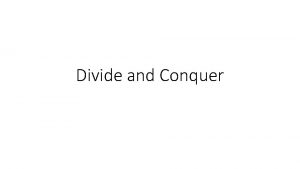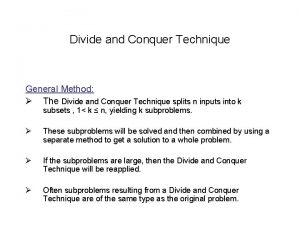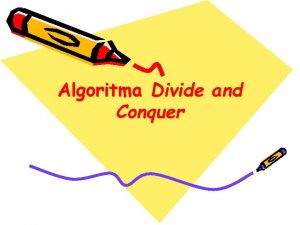Divide and Conquer Algorithms Divide and Conquer Generic


































- Slides: 34

Divide and Conquer Algorithms

Divide and Conquer • Generic recipe for many solutions: • Divide the problem into two or more smaller instances of the same problem • Conquer the smaller instances using recursion (or a base case) • Combine the answers to solve the original problem

Integer Multiplication • Assume we want to multiply two n-bit integers with n a power of two • Divide: break the integers into two n/2 -bit integers

Integer Multiplication • Conquer: Solve the problem of multiplying of n/2 bit integers by recursion or a base case for n=1, n=2, or n=4

Integer Multiplication • Now combine: • In the naïve way:

Integer Multiplication • We count the number of multiplications • • Multiplying by powers of 2 is just shifting, so they do not count number of bit multiplications for integers with bits: • Recursion:

Integer Multiplication • Solving the recursion • Intuition:

Integer Multiplication • • Proposition: Proof by induction: • Induction base: • Induction step: Assume • Proof: . Show

Integer Multiplication • Since the number of bits is • Number of multiplications is • This is not better than normal multiplication

Integer Multiplication • Now combine: • Instead: • • Use This reuses two multiplications that are already used

Integer Multiplication • We need to deal with the potential overflow in calculating

Integer Multiplication • Now, we only do three multiplications of order to multiply two bit numbers • The recursion becomes bit numbers in

Integer Multiplication • Solving the recurrence • Heuristics:

Integer Multiplication • As before prove exactly using induction

Integer Multiplication • The multiplication of two -bit numbers takes

Integer Multiplication • This way, multiplication of m-bit numbers takes bit multiplications

Integer Multiplication • • Can be used for arbitrary length integer multiplication • But can still do better using Fast Fourier Transformation Base case is 32 or 64 bits

Binary Search • • Given an array of ordered integers, a pointer to the beginning and to the end of a portion of the array, decide whether an element is in the slice Search(array, beg, end, element)

Binary Search • Divide: Determine the middle element. This divides the array into two subsets • Conquer: Compare the element with the middle element. If it is smaller, find out whether the element is in the left half, otherwise, whether the element is in the right half • Combine: Just return the answer to the one question

Binary Search def binary_search(array, beg, end, key): if beg >= end: return False mid = (beg+end)//2 if array[mid]==key: return True elif array[mid] > key: return binary_search(array, beg, mid, key) else: return binary_search(array, mid+1, end, key) test = [2, 3, 5, 6, 12, 15, 17, 19, 21, 23, 27, 29, 31, 33, 35, 39, 41] print(binary_search(test, 0, len(test), 21)) print(binary_search(test, 0, len(test), 22))

Binary Search • Let be the runtime of binary_search on a subarray with n elements • Recursion: There is a constant c such that

Binary Search • Solving the recursion • If then

Binary Search • With other words, binary search on n elements takes time

Strassen Multiplication • Definition of Matrix Multiplication i row j column row i column j

Strassen Multiplication • • Cost of definition: multiplications for all elements in the product • Square matrices: elements

Strassen Multiplication • • Divide and conquer: Assume is a power of two. We can use the following theorem: • Break each matrix into four submatrices of size and calculate

Strassen Multiplication • As is, a divide and conquer algorithm gives us 8 multiplication of matrices half the size. • Let be the number of multiplications needed to multiply two matrices using divide and conquer • • Obviously: Recursion:

Strassen Multiplication • • • Claim: Proof: Induction base: Induction step: • • Hypothesis: To show: • Proof:

Strassen Multiplication • That is the same as the normal algorithm!!!!!!!!!!!!!!

Strassen Multiplication • Strassen: Can use 7 matrix multiplications to calculate all eight products

Strassen Multiplication • Then can get all the submatrices on the right:

Strassen Multiplication • Now the recurrence becomes • which is obviously solved by • .

Strassen Multiplication • • Remember that the size of the matrix was. • Since Thus, if is the number of multiplications for an matrix with power of 2 rows, then

Strassen Multiplication • The algorithm can be extended for matrices that • have number of rows = number of columns not a power of 2 • are not square
 Divide and conquer advantages and disadvantages
Divide and conquer advantages and disadvantages Divide and conquer vs greedy
Divide and conquer vs greedy Delaunay triangulation divide and conquer algorithm
Delaunay triangulation divide and conquer algorithm Delaunay triangulation divide and conquer algorithm
Delaunay triangulation divide and conquer algorithm Counting inversions divide and conquer
Counting inversions divide and conquer Metoda divide et impera c++
Metoda divide et impera c++ Divide and conquer
Divide and conquer Dynamic programming vs divide and conquer
Dynamic programming vs divide and conquer Prove correctness of divide and conquer
Prove correctness of divide and conquer Tiling problem divide and conquer
Tiling problem divide and conquer Divide and conquer algorithm examples
Divide and conquer algorithm examples Euclidean algorithm divide and conquer
Euclidean algorithm divide and conquer How to divide in pseudocode
How to divide in pseudocode Divide and conquer recurrence relation
Divide and conquer recurrence relation Contoh algoritma divide and conquer
Contoh algoritma divide and conquer Defective chessboard problem divide and conquer
Defective chessboard problem divide and conquer Divide and conquer algorithm
Divide and conquer algorithm Divide and conquer algoritma
Divide and conquer algoritma Knapsack problem divide and conquer
Knapsack problem divide and conquer Foyer inn form hay shun gibberish
Foyer inn form hay shun gibberish Powering a number divide and conquer
Powering a number divide and conquer Is shell sort divide and conquer
Is shell sort divide and conquer Gavin soorma
Gavin soorma Divide and conquer complexity
Divide and conquer complexity Divide ut imperes
Divide ut imperes Nnn sort
Nnn sort Divide and conquer
Divide and conquer Divide and conquer
Divide and conquer Conquer
Conquer Divide and conquer
Divide and conquer Application of divide and conquer
Application of divide and conquer Steps of divide and conquer approach *
Steps of divide and conquer approach * Digital divide and conquer
Digital divide and conquer Why do historians divide history into eras
Why do historians divide history into eras Multiplication divide and conquer
Multiplication divide and conquer

